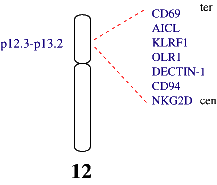C-type lectins
Animal lectins are sugar-binding proteins that mediate both pathogen recognition and cell-cell interactions. Many of these proteins belong to the Ca2+-dependent (C-type) lectin family that contain structurally related carbohydrate recognition domains (CRDs). The common sequence motif of the C-type CRDs is characterized by the presence of 14 invariant and 18 highly conserved residues which determine the folding of this type of module. However, many protein modules containing part of or the entire C-type CRD motif confer functions other than saccharide recognition and have been designated as C-type lectin-like domains (CTLDs).
The genes coding for the C-type lectins that bear a single CTLD (lectin-like receptors) are localized in a single genomic region which shows conservation of synteny in rodents and humans. The NK gene complex is located in human on chromosome 12p13.2 and, in mouse on chromosome 6, and named the natural killer (NK) gene complex (NKC). 19 C-type lectin and lectin-like receptor genes have been localized within Chromosome (Chr) 12p12.3-p13.2 spanning the human NKC. This cluster of genes includes LY49L, the NKG2 family, CD94, CLEC-1, CLEC-2, OLR1, KLRF1, AICL, CD69, LLT1, NKR-P1A, MAFA-L, M6PR, DCIR, DLEC and DECTIN-1 (CLECS.F12)[1]. The similar genomic structure of these genes has led to the hypothesis that they derive from a single ancestral gene.
Some of these genes show a wide pattern of expression in the hematopoietic lineage (CD69, AICL), whereas others are restricted to NK cells and some T cell subpopulations (NKG2, CD94, NKR-P1A), to dendritic cells (DCs) as CLEC-1, DLEC or DECTIN-1, or to vascular endothelial cells, such as the OLR1/OX-LDL gene that codes for an oxidized low-density lipoprotein receptor.
DECTIN-1, a type II transmembrane glycoprotein, is coded by 6 exons. Exon 1 encodes the N-terminal 34 aa of the cytoplasmic region. Exon 2 encodes 33 aa located mainly in the transmembrane region. Exon 3 encodes 46 aa of the stable region, and exons 4-6 encode the CTLD domain [1].

[1] Hernanz-Falcon P. et al. (2001) Immunogenetics 53, 288-295.



